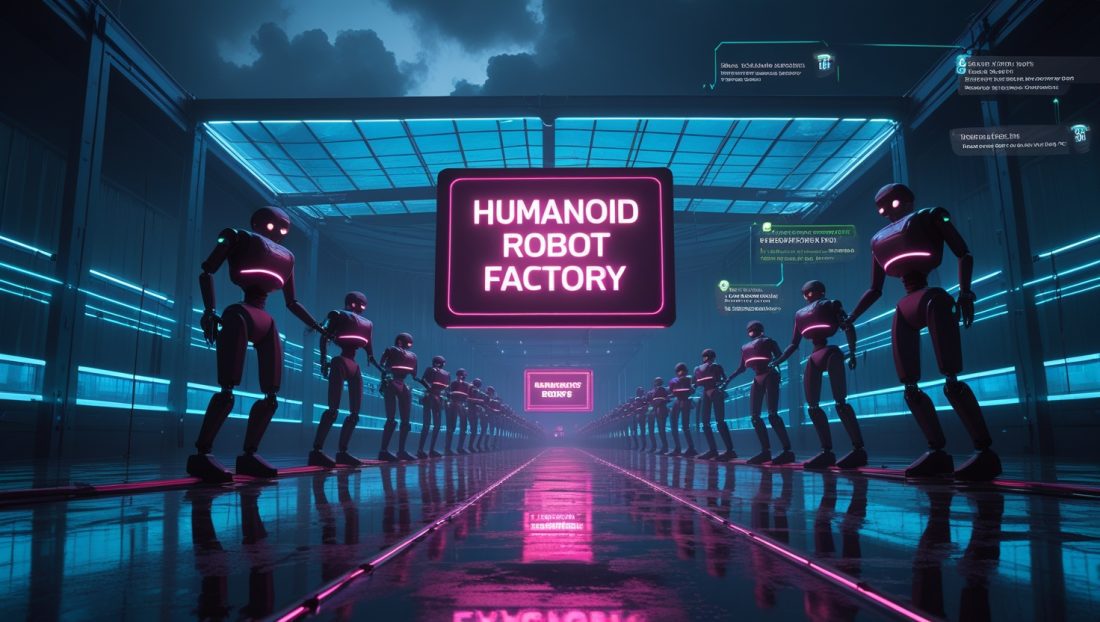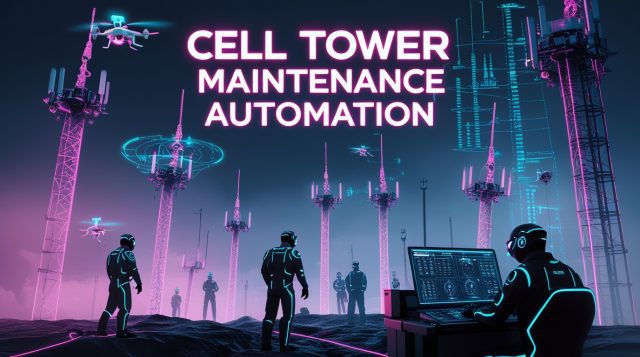The Texas Transformation: Inside Nvidia and Foxconn’s $38 Billion Bet on Humanoid-Powered Factories
“In the era of AI, every manufacturer needs two factories: one for making things, and one for creating the intelligence that powers them.”
— Jensen Huang, NVIDIA CEO
I. Dawn of the Humanoid Robot Factory: Houston’s 2026 Milestone
In early 2026, a Houston humanoid robot factory will awaken with a new kind of labor force. Rows of humanoid robots will assemble NVIDIA’s Blackwell GB300 AI servers—marking the first time the chipmaker’s products are built by machines mirroring human dexterity. This $38 billion venture between NVIDIA and Foxconn isn’t merely automation: it’s a strategic reinvention of global manufacturing. Learn how such advancements align with cloud-connected humanoid robots transforming industry.
Foxconn, the world’s largest electronics manufacturer, designed this facility specifically for robotic integration. Its spacious layout contrasts sharply with older factories constrained for human labor. As Foxconn executive Leo Guo noted: “The larger footprint allows seamless deployment of humanoids for tasks like cable insertion and component handling.”
II. The Strategic Imperative: Why Humanoids?
A. Reshoring Against Geopolitical Winds
The Texas factory counters two critical vulnerabilities: supply chain instability and skilled labor shortages. By 2025, 75% of large manufacturers planned production reshoring, per McKinsey. NVIDIA’s partnership with Foxconn—and Wistron in Dallas—exemplifies this shift. Domestic AI server production slashes tariffs and shipping delays while accelerating client deliveries. This move echoes trends in industrial AI and digital twins transforming global manufacturing.
B. Precision Beyond Traditional Automation
Traditional robots struggle with micro-scale tasks like threading flexible cables. Humanoids solve this through AI-guided force sensitivity. Foxconn’s May 2025 demonstrations proved they could reduce defect rates by 40% compared to manual assembly.
Humanoid Robot Manufacturing Efficiency
The 2025 Humanoid Robot Study by Nexery highlights how advanced AI-powered humanoids are transforming high-stakes manufacturing. These robots bring real-time adaptability and nuanced dexterity to complex assembly lines—particularly in sectors like AI server production—unlocking significant gains in throughput and efficiency. Their precision and scalability position them as pivotal tools in the evolution of factory automation.
Deepu Talla, NVIDIA VP of Robotics: “The ChatGPT moment for physical AI is around the corner.”
III. Technological Architecture: The Stack Powering Autonomy
A. Brains: Isaac GR00T and Omniverse
NVIDIA’s Isaac GR00T (Generalist Robot 00 Technology) processes multimodal data—vision, tactile feedback, spatial audio—letting robots navigate unstructured environments. At the Houston plant, they’ll dynamically adjust workflows upon detecting anomalies. This capability builds on innovations in multimodal robotic skin enhancing industrial AI.
Behind scenes, Foxconn’s Omniverse Digital Twin simulates production lines. Using NVIDIA’s OpenUSD framework, engineers optimize layouts virtually. Result: Factory setup time drops 50%, thermal analysis accelerates 150x via PhysicsNeMo AI.
B. Hardware Evolution: Wheels vs. Legs
Foxconn’s November 2025 showcase will debut two models:
- Bipedal units for vertical mobility
- Wheeled AMRs (Autonomous Mobile Robots) for cost-efficient transport
UBTech’s Chinese robots remain in testing, but insiders hint Foxconn favors proprietary NVIDIA-enhanced designs. Wheeled variants may dominate initial deployment, priced 30% lower. This strategic choice aligns with why autonomous mobile robots dominate logistics.
IV. Global Arms Race: China’s Patent Surge vs. U.S. Innovation
A. China’s Accelerated Dominance
China leads with 5,688 robotics patents since 2020—four times the U.S. total. Its market will rocket from $377 million (2024) to $10.26 billion by 2029. Events like Beijing’s humanoid half-marathon—where 21 robots completed 13 miles—signal scalable prowess. For context, see how China’s robotics shift sparks global concerns.
Robotic Workforce Scalability
China’s state-supported robotics ecosystem is rapidly scaling humanoid deployment, with companies like Unitree Robotics leading the charge. According to a 2025 report by SCMP, Unitree’s CEO predicts that humanoid robots will “reach a whole new level” by year’s end, reflecting the country’s aggressive push toward industrial automation.
B. Industry Titans Mobilize
- Tesla: Optimus robots’ trial in Fremont factories
- Mercedes/BMW: Testing humanoids for high-risk tasks
- SoftBank: Pursuing “Project Crystal Land,” a $1 trillion robotics/AI campus in Arizona
Goldman Sachs forecasts 250 million humanoids in factories by 2035. This race mirrors advancements in BMW’s humanoid robot precision manufacturing.
V. Human-Robot Symbiosis: Augmentation Over Replacement
Foxconn positions humanoids as collaborative tools, not replacements. At its Taiwan facilities, robots handle repetitive tasks while technicians oversee quality control. This “co-bot” model:
- Reduces ergonomic injuries by 60%
- Upskills workers into robotics supervision roles
- Boosts output per shift 35%
Maria Rodriguez, a Foxconn assembly veteran training in Kaohsiung, shared: “Learning to manage robot teams felt daunting initially. Now, I focus on solving complex errors—less strain, more brain.” (Name changed). This symbiosis reflects trends in why robot behavior influence boosts industrial AI.
VI. Challenges: Technical and Ethical Frontiers
A. Performance Hurdles
- Power Constraints: Mobile units require frequent charging vs. wired arms
- Sensor Limitations: Struggles with reflective surfaces or tangled cables
- AI Reliability: Real-world unpredictability demands collision fail-safes
AI-Driven Factory Automation 2025
A 2025 Gartner report underscores the critical role of high-quality training data in humanoid robotics, warning that poor data governance and synthetic data mismanagement could jeopardize AI model accuracy and compliance. To address these challenges, NVIDIA’s Isaac GR00T platform leverages simulation-based training and virtual stress-testing to accelerate robot learning and reduce error rates—cutting development costs while boosting real-world performance.
B. Ethical Guardrails
The World Economic Forum urges “multi-tiered safeguards”:
- Technical: Emergency cutoffs, ethical AI training
- Corporate: Transparent human-robot ratios
- Governmental: Reskilling subsidies
These concerns tie into broader discussions on humanoid robot safety concerns rising globally.
VII. Beyond 2026: The Scalable Blueprint
Success in Houston could spawn industry-wide replication:
- Electronics: Apple’s iPhone assembly
- Automotive: EV battery integration
- Logistics: Amazon’s last-mile delivery hubs
Foxconn’s parallel Taiwan “AI supercomputer” project—featuring 10,000 Blackwell GPUs—aims to interconnect global robotic ecosystems, enabling real-time knowledge sharing from Houston to Hyderabad. This vision aligns with Amazon’s warehouse automation debates.
VIII. The Symbiotic Factory Floor
The Houston experiment embodies manufacturing’s next era: human creativity directing robotic precision. By 2030, factories may operate as collaborative ecosystems where technicians and algorithms co-innovate. As Huang declared: “This infrastructure accelerates innovation into the age of robotics.” For more on this future, explore why robotics is reshaping global manufacturing.
Your Next Step?
Track this transformation—subscribe to our Newsletter for more upcoming updates on Houston’s 2026 launch and global robotics adoption.


